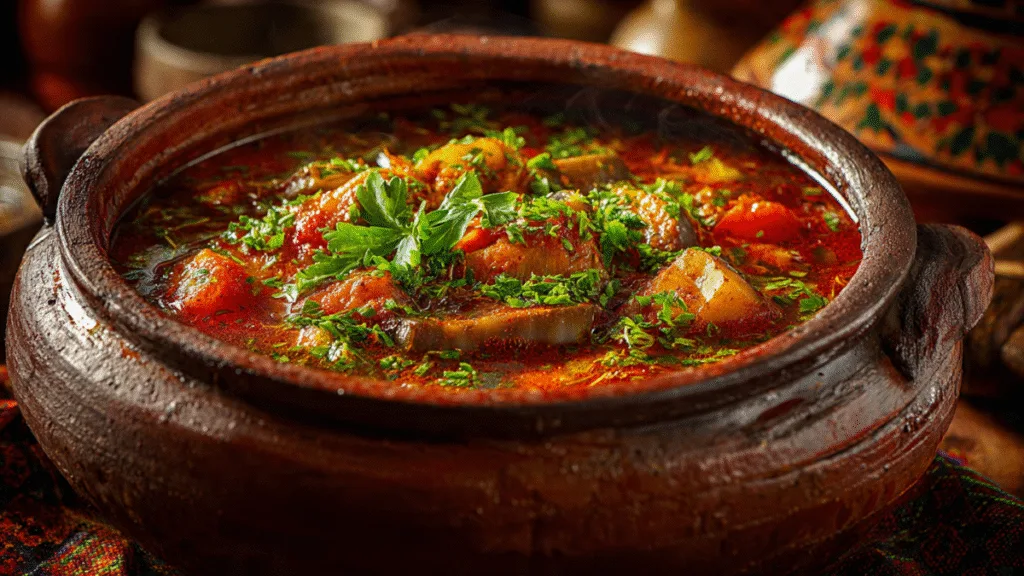Ever find yourself staring into the abyss of your refrigerator, wondering what on earth to make for dinner? Again? I’ve been there more times than I can count. You want something delicious, something that feels a little special, but also something that won’t require a culinary degree and a sous chef to pull off. What if I told you the answer involves a humble eggplant and a journey to flavor town?
Enter Khoresh Bademjan, or as we’ll call it, Persian Eggplant Stew. This isn’t just another one of those stew recipes; it’s a game-changer. It’s the kind of family-friendly dinner that has everyone asking for seconds. I stumbled upon this gem during a deep dive into comfort food from around the world, and let’s just say, my weeknight dinner routine has never been the same. It’s rich, savory, and surprisingly easy. So, are you ready to become a legend in your own kitchen?

What Exactly Is This Magical Stew?
Khoresh Bademjan is a classic Persian stew that stars tender, melt-in-your-mouth eggplant simmered in a rich tomato-based sauce. It’s a cornerstone of Iranian cuisine, and every family seems to have its own slightly different—and obviously superior—version. The name itself translates to “eggplant stew,” a simple title for a dish with such a complex and soul-satisfying flavor profile.
This isn’t just food; it’s a cultural experience. It’s the kind of dish that brings people together, perfect for a cozy night in or for impressing guests. And the best part? It’s one of those amazing light recipes that doesn’t sit heavy, despite its deep, rich taste.
Why You’ll Absolutely Adore This Recipe
Still on the fence? Let me break down why this Persian Eggplant Stew is about to become your new go-to.
- Incredibly Flavorful: We’re talking layers of flavor here. The savory meat, the tangy tomatoes, the earthy spices, and the creamy eggplant all come together in a symphony of deliciousness.
- Surprisingly Easy: Don’t let the exotic name fool you. If you can brown meat and chop some veggies, you can absolutely nail this dish. It’s a perfect easy dinner recipe for a busy weeknight.
- Versatile and Forgiving: You can easily adapt this recipe to your liking. Swap the meat, make it vegetarian, or adjust the spices. It’s pretty hard to mess up, IMO.
- Healthy-ish: Packed with vegetables and protein, it’s a dish you can feel good about serving. Eggplant itself is a fantastic source of fiber and antioxidants.
Let’s Talk Ingredients, Shall We?
Alright, let’s get down to the nitty-gritty. The ingredient list might look a bit long, but trust me, most of this stuff is probably already hanging out in your pantry.
For the Stew:
- The Star: Eggplant: You’ll need about 2-3 medium-sized eggplants. Look for ones that are firm and have smooth, shiny skin.
- The Protein: Traditionally, this stew is made with lamb or beef stew meat, cut into 1-inch cubes. About 1.5 pounds will do the trick.
- The Base: One large onion, finely chopped, is essential. This is where the flavor foundation begins.
- The Sauce: A can of crushed tomatoes (28 ounces, to be exact) is the heart of the sauce.
- The Spices: This is where the magic happens. You’ll need turmeric, cinnamon, salt, and black pepper. Some recipes also call for a pinch of saffron for that extra touch of luxury.
- The Tang: Dried limes (known as Limo Amani in Persian) or fresh lemon juice provide a unique, tangy counterpoint to the rich sauce.
For Garnish (Don’t Skip This!):
- A little fresh parsley or mint can brighten things up at the end.
The Step-by-Step Guide to Glory
Ready to start cooking dinner? Let’s walk through this together. Take a deep breath; you’ve got this.
Step 1: Prep Your Eggplant (The Secret to Success)
This is arguably the most crucial step for perfect eggplant recipes. We need to get rid of any potential bitterness from the eggplant.
First, peel your eggplants. Some people like to leave stripes of skin on for texture, which is totally fine. Then, slice them lengthwise into about half-inch thick pieces. Now, for the important part: salt them. Lay the slices on a baking sheet, sprinkle generously with salt on both sides, and let them sit for about 30-60 minutes. You’ll see beads of moisture form on the surface. This process, called “sweating,” draws out the bitter juices. After they’ve sweat, rinse the slices thoroughly with cold water and pat them completely dry with paper towels. Seriously, get them dry.
Step 2: Searing and Sautéing
In a large pot or Dutch oven, heat a couple of tablespoons of oil over medium-high heat. Pat your stew meat dry (another crucial step for a good sear!) and season it with salt and pepper. Add the meat to the pot in a single layer—don’t overcrowd it—and brown it on all sides. You’re not cooking it through, just getting a nice color on it. Once browned, remove the meat and set it aside.
Toss your chopped onion into the same pot. You might need to add a bit more oil. Sauté the onion until it’s soft and golden, which usually takes about 5-7 minutes. Then, add your spices: turmeric, cinnamon, and a good pinch of black pepper. Stir everything around for about a minute until it’s fragrant. This is called “blooming” the spices, and it makes a huge difference in the final flavor.
Step 3: Let the Simmering Commence
Now, return the browned meat to the pot. Pour in the crushed tomatoes and about a cup of water or broth. If you’re using dried limes, poke a few holes in them with a fork and toss them in. Bring the mixture to a boil, then reduce the heat to low, cover the pot, and let it simmer away for at least 1.5 to 2 hours. The longer, the better. You want the meat to be fall-apart tender.
Step 4: Cooking the Eggplant
While your stew is simmering and making your house smell amazing, it’s time to cook the eggplant. You have two options here: frying or baking.
- Frying (The Traditional Way): Heat about an inch of neutral oil in a large skillet over medium-high heat. Carefully place the eggplant slices in the hot oil, being careful not to crowd the pan. Fry them for a few minutes on each side until they are golden brown and tender. Transfer them to a paper towel-lined plate to drain off any excess oil.
- Baking (The Healthier Way): If you’re looking for one of those light recipes, this is your move. Preheat your oven to 400°F (200°C). Lightly brush the eggplant slices with olive oil on both sides and arrange them on a baking sheet. Bake for about 20-25 minutes, flipping halfway through, until they are golden and soft.
Step 5: The Grand Finale
About 30 minutes before you’re ready to serve, it’s time to unite the eggplant and the stew. Gently nestle the cooked eggplant slices into the pot with the meat and sauce. Be gentle; you don’t want to break them up too much. If you’re using lemon juice instead of dried limes, now is the time to stir it in.
Cover the pot again and let everything simmer together for that final half hour. This allows the eggplant to absorb all that delicious, savory sauce. Have a taste and adjust the seasoning if needed. Maybe a little more salt? A bit more lemon juice? You’re the chef here.
How to Serve Your Masterpiece
The classic way to serve this Persian Eggplant Stew is over a bed of fluffy basmati rice, particularly with a crispy bottom layer known as Tahdig. Don’t worry if you can’t nail the Tahdig on your first try; plain steamed rice is still a perfect companion.
Garnish with some fresh, chopped parsley or mint to add a pop of color and freshness. A simple side salad of cucumbers and tomatoes dressed with a little lemon juice and olive oil also pairs beautifully.
Pro Tips and Fun Variations
Ready to take your stew to the next level? Here are a few thoughts and variations to play with.
- Make it Vegetarian: This is an easy one! Simply omit the meat and add a can of chickpeas or some pan-fried halloumi cheese during the last 30 minutes of cooking. You can also use a hearty vegetable broth to build the sauce’s flavor.
- Spice It Up: If you like a little heat, add a pinch of cayenne pepper or a chopped chili to the onion mixture.
- A Note on Saffron: If you want to get really fancy, bloom a pinch of saffron threads in a tablespoon of hot water and stir it into the stew at the very end. It adds an incredible aroma and a beautiful golden hue.
- Sour Grapes? Another traditional ingredient is ghooreh, or sour grapes. If you can find them at a Middle Eastern market, they add a fantastic pop of tartness. Add them in the last 30 minutes of cooking. FYI, it’s a game-changer.
This Persian Eggplant Stew is more than just a recipe; it’s an invitation to explore a rich and flavorful cuisine. It’s a dish that proves that easy dinner recipes don’t have to be boring. It’s a warm, comforting hug in a bowl, perfect for sharing with the people you love. So go ahead, give it a try. I have a feeling it’s going to become a regular in your rotation. You might even find yourself feeling a little bit famous.


